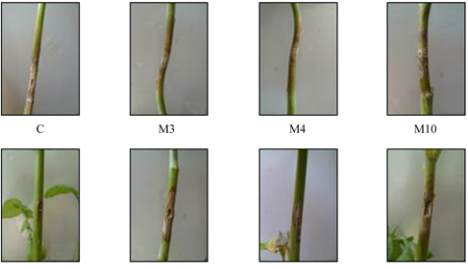Basic HTML Version



Molecular Plant Breeding 2013, Vol.4, No. 30, 247
-
253
http://mpb.sophiapublisher.com
249
Figure 3 qRT-PCR analysis of
MSI-99m
expression in
transgenic lines and wild-type plants
Note: C: wild-type plants as control; M3, M4, M10, M14, M16,
M19, M21: transgenic lines M3, M4, M10, M14, M16, M19,
M21, respectively
a full scale necrotic area and substantial fungus
mycelium grown around the surface of leaves. While
transgenic lines except line M10 showed some light
watery spots and still kept a healthy dark green
coloration (Figure 4A). The disease index of the
transgenic lines and the wild type are shown in Figure
4B and they were lower in all transgenic lines than in
the wild-type controls except line M10, with even
significant differences present among the transgenic lines.
Figure 4 Evaluation of detached leaf for resistance to
S. Sclerotiorum
Note: Photos and data were collected after 4 days of
inoculation; A: Appearance of detached leaves in control and
transgenic rape after inoculation with
S. sclerotiorum
; B:
Disease index of detached leaves in control and transgenic rape
after co-cultivation with
S. sclerotiorum
1.3.2 Adult plants assay
The adult plants of 7 transgenic lines and the
wild-type control were inoculated using mycelia
inoculation method, the lesion expanded up and down
the stem from the inoculation point after 4 days. The
appearance of rape stem inoculated with
S.
Sclerotiorum
is provided in Figure 5A. The lesion was
approximately 13 cm long on the control plant
inoculated with
S. sclerotiorum
for 7 days, while it
varied from 0.5 cm to 10.9 cm on the transgenic lines
carrying
MSI-99m.
The
disease
index of all the
transgenic lines were lower than in the control, of
which line M14 was the more resistant with a disease
index of 8. 9 (Figure 5B).
Figure 5 Evaluation of adult plant for resistance to
S.
Sclerotiorum
Note: Photos and data were collected after 7 days of
inoculation; A: Appearance of transgenic rape and control line
during florescence inoculated with
S. sclerotiorum
; B: Disease
index of transgenic rape and control line during florescence
inoculated with
S. Sclerotiorum
2 Discussion
Sclerotina
rot caused by
Sclerotinia sclerotiorum
is
one of the most severe diseases in rape and would
cause huge economic losses (Dong et al., 2008). The

